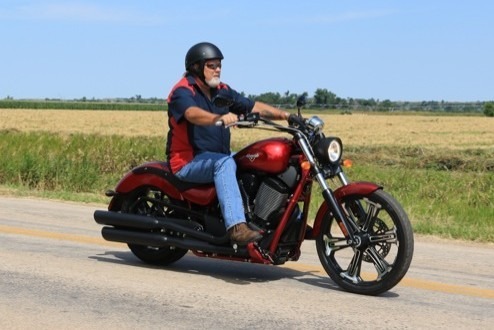Sturgis, S.D.—The year 2003 was a breakout year for Victory Motorcycles, a turning point in the future of the brand. And this monumental moment was fueled by the introduction of a single new model, the Victory Vegas. Up until this time sales of the Victory line were disheartening to say the least. Although they had recently released a new and improved engine, the American consumer showed little interest. So company officials took a hard look at the probable causes and discovered that although they were manufacturing a sound product that provided all the utilitarian needs of a rider, it looked like a piece of farm equipment. In their quest to produce a reliable product, they placed function before form. The major problem with that line of direction was not only did form follow function; it followed from several miles away. Simply put, their machines had not a hint of sexiness. And as is common knowledge, in America sex sells, especially when it comes to big-bike customers. The result of all this corporate head scratching was the creation of the 2003 Vegas, without a doubt the most stylish cruiser on the American market at the time. So what’s changed in 13 years for this sex machine?

In 2010 Victory introduced its 106 Freedom V-Twin engine, which has become the standard powerplant for all their models. And for the 2016 Vegas this mill is just as solid as ever, delivering a strong 97 hp—plenty of ponies for this 655 lb. cruiser. The 2003 Vegas came with a 92-inch V-twin, producing a puny 80 hp, and a 5-speed tranny. Offering a butt-load of torque on demand, the 106 smoothly delivers all that ummph to the tarmac via a 6-speed transmission that seems to lope along at highway speeds (5th gear is adequate for 65 mph only hitting 2600 rpm while 6th gear is best utilized at speeds above 75). The fuel injection is flawless with head-snapping throttle response and plenty of passing power on tap.

The 2003 Vegas saw the introduction of a completely redesigned chassis that used a vertical mono-shock system that articulates on a rising rate link all tied into a forged aluminum swingarm. Since then this design has become the standard for the entire Victory line. This arrangement allowed the 2003 Vegas to offer a seat height of 26.5 inches. During the following 13 years that height has been slowly whittled down with the 2013 Vegas’ seat a scant 25.2 inches off the pavement. This seating height allows for a low center of gravity and begs the rider to throw the bike into corners while remaining confident in the outcome. The telescopic front forks provide a whopping 5.1 inches of travel.

One constant that has remained over the years is the bike’s curvaceous fuel tank—a centerpiece that ties all the other pieces together. Featuring the signature ridge that runs down its center, it tapers to a V-notch that dovetails into the seat. That beveled ridge then continues down the rear fender even incorporating that facet onto the lens of the recessed taillight. And although the tank badges have evolved over the years, the original comet-like indented swirls surrounding the company name remain—don’t mess with what don’t need fixing.
The slim solo seat is deceptively comfortable, something the 2003 model was not noted for. An optional passenger pillion is in the stockpile of Victory accessories and mounts cleanly, slightly floating above the rear fender. If you prefer the lonesome highway, a luggage rack in place of a passenger seat is also available.

Wheels sizes haven’t changed that much over the years with a 21″ still leading the way followed by an 18” in the rear. Rear rubber did get a little bigger with age, the Vegas sporting a 180mm for 2016. But long gone are the spokes from yesteryear. New for 2016 is the Vegas Falchion Wheels fore and aft, a very attractive hollow-ribbed mag with machined highlights. The Falchion name comes from a one-handed sword known for its versatility—carving through the canyons perhaps?
Braking duties are handled by a single 4-piston caliper up front and a 2-pot caliper on the rear. Both ride on 300mm rotors and provide substantial and stable stopping power whether used separately or in tandem.

New for 2016 is a color-matched frame that adds a truly custom look. The Sunset Red paint even includes the forward controls, shift lever and brake pedal for a unique effect that is so well applied it almost appears to be powder coated. And while a sleek new headlight design streamlines the bike, a tangle of wires and cables behind the headlamp shell destroys the look. The 2003 version of the Vegas had an instrument cluster with all the idiot lights encased in the top triple clamp. All the warning lights and signals were relocated in later years and now find a home nestled inside the speedometer housing. And while it may make for a superior package, it leaves a lot to be desired in appearance. This is one of my few complaints about the 2013 Vegas but is an area that needs to be addressed in the future especially on such a pretty bike. The only other complaint I have would be the turn signals, one aesthetic and the other operational. The basic design of the original turn signals themselves have not changed and are just as cheesy as they were 13 years ago. They really do not have a place on a bike this classy. Secondly, to this day they remain non-self-canceling, causing this operator to spend a lot of time riding around Sturgis this year looking like a newbie. Funny thing, both of these complaints were mentioned in our ride review of the first Vegas way back in THUNDER PRESS December 2002.

Standing a 2003 alongside a 2016 model, they would appear to be almost identical except for a few refinements. When Victory first envisioned the Vegas design and then was able to actually forge a finished product that did not swerve outside those creative parameters, they fashioned a classic cruiser, maybe the best ever. As proof of that statement, the Vegas is the longest-running production model in the Victory lineup—it’s been that popular over the years with many of its innovations finding a home on the other models. There have been little refinements along the way, some incremental, but refinements nonetheless. And let’s not forget one major change between the 2003 and the 2016 models. After 13 years of incremental refinements, the 2016 Vegas is $1,500 less, coming in with a MSRP of $13,499. Now if they would just fix those damn turn signals.




















Sharp thgnkini! Thanks for the answer.
I love this bike.
My Vegas turn signals operate as advertised most of the time. I hold to change lanes release and they stop. Turn them on to turn and they cancel. Maybe not as fast as a steering column cam switch on a cage. There have been a couple of time when taking a fork in the road that they haven’t cancelled. Simply pushing in on the switch tirns it off.